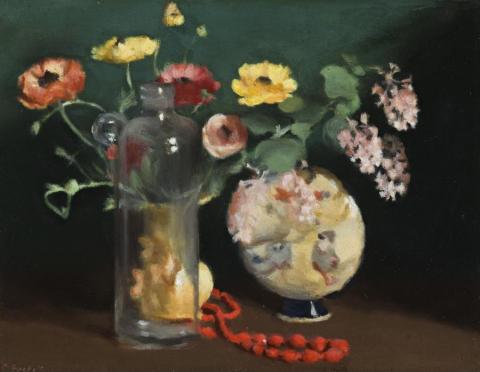RANUNCULI WITH CORAL BEADS, c.1924
CLARICE BECKETT
oil on board
34.0 x 44.0 cm
signed lower left: C Beckett
Private collection
Christie's, Melbourne, 1 May 2000, lot 115
Collection of Lex Aitken and Alfredo (Bouret) Gonzalez, Sydney
Clarice Beckett: Politically Incorrect, The Ian Potter Museum of Art, The University of Melbourne, Melbourne;
SH Ervin Gallery (National Trust of Australia), Sydney;
Orange Regional Gallery, New South Wales;
Art Gallery of South Australia, Adelaide;
Bendigo Art Gallery, Victoria;
Tasmanian Museum and Art Gallery, Hobart;
Burnie Regional Art Gallery, Tasmania, 5 February 1999 – 22 May 2000, cat. no. 8 (label attached verso)
Hollinrake, R., Clarice Beckett, the Artist and her Circle, Macmillan, Melbourne, 1979, p. 53 (illus.)
Hollinrake, R., Clarice Beckett: Politically Incorrect, The Ian Potter Museum of Art, The University of Melbourne, Melbourne, 1999, cat. 8, p. 75
Still life subjects are suited to the art of Clarice Beckett as stillness was so much a part of her creativity. In her lifetime, paintings of flowers were favoured more than landscapes, and their bright colours always caught the eye of the viewer. Asters, carnations, roses, and petunias were the single and group subjects of numerous still life paintings exhibited in the spring and autumn exhibitions of the Victorian Artists' Society in East Melbourne during the twenties. Her first solo exhibition in 1923 featured so many flower paintings that the review in the Sun News-Pictorial was headed 'Vases and Flowers: Miss Beckett's Art'. 'Nearly 80 paintings by Miss Clarice Beckett were exhibited yesterday at the Athenaeum. There is one portrait; the rest are land or seascapes, and some effective still life studies. Daisies; and Mr Sherlock's Asters, and a Japanese Vase show the artist at her best.'1
Ranunculi with Coral Beads, c1924 provided Beckett with the opportunity to paint an essay of glowing colour and light, soft of focus with highlights that sparkle. The translucency of the glass bottle reveals a yellow vase and ranunculi beyond, balanced by the decorated Oriental ceramic vessel to the right. As a mirage of beauty, it is tantalizingly close, yet seemingly as ephemeral as mist. In her Memorial Exhibition of 1936, held at the Athenaeum, Melbourne, flowers played a significant part, The Wattle being a lone native among the camellias and chrysanthemums. Beckett's champion, Rosalind Hollinrake, noted that, 'Unlike her contemporaries Ellis Rowan and Margaret Preston, Beckett did not paint native flowers.'2 She acknowledged one exception, the painting title 'Gladioli' exhibited at the Victorian Artists' Society in 1922, to which gum leaves had been added. 'Her attitude to native flora', Hollinrake continued,'was that the Australian bush was fragile despite its seeming hardiness and that bush flowers should be left where they belong.'3 The Wattle shows she made an occasional exception, but natives did not lure her away from the range of colour and form offered by exotics.
Of her many works in public collections, Marigolds (Still Life), 1925 in the collection of the Castlemaine Art Gallery and Historical Museum, Victoria, is like our painting in being among the best. It was one of the first works by Beckett to enter a public art gallery. Both were included in the retrospective, Clarice Beckett: Politically Incorrect, toured by the Ian Potter Museum of Art, University of Melbourne in 1999-2000. They show that her understanding of beauty was not confined to landscapes. In Ranunculi with Coral Beads, the modulated background provides the perfect setting for a harmony of hues in which the casual gesture of coral beads proclaims her mastery of ravishing colour.
1. Sun News-Pictorial, Melbourne, 5 June 1923, p. 9
2. Hollinrake, R., Clarice Beckett: Politically Incorrect, Ian Potter Museum of Art, Melbourne, 1999, p. 16
3. Ibid.
DAVID THOMAS
